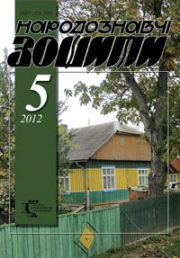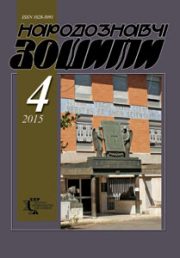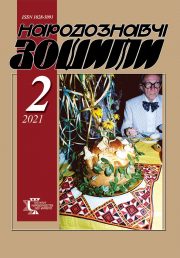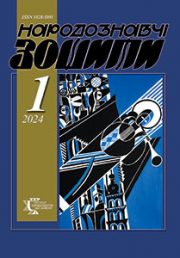The Ethnology Notebooks. 2020. № 2 (152), 420—434
UDK 001.3-026.451(=161.2:438.31)”19/20″
DOI https://doi.org/10.15407/nz2020.02.420
KRYVENKO Anastasiia
ORCID ID: https://orcid.org/0000-0001-9353-2919
Candidate of Sciences in History, Researcher
of the Institute of Ethnology of the National Academy
of Sciences of Ukraine,
in the department of Modern Ethnology,
Svobody Avenue 15, 79000, Lviv, Ukraine
Contacts: e-mail: n.d.kryvenko@gmail.com
Abstract. The research of the Polish-Ukrainian cooperation in the Ukrainian studies centers in Crakow is a scientifically actual and socially necessary task. There is a lack of special articles about the state of Ukrainian studies in Poland, in particular in Cracow. There is also lack of knowledge about scientific events on both sides and socio-political challenges related to different traditions of interpretation of historical events by the scientists in both of the states, their politicization and the necessity to continue the international scientific dialogue in the process of the integration of Ukrainian science in the international contemporary science. The goal of the article is to trace the trends in the development of research and education in the field of Ukrainian studies in Cracow, — to analize their influence on the process of strengthening of the Polish-Ukrainian partnership. The object of the article is activity of the Cracow Ukrainian Studies Center: scientific institutions, it’s main representatives and initiators of the international Polish-Ukrainian cooperation. The subject of the researcj are the main directions, results, the difficulties and prospects of the international cooperation between Polish and Ukrainian researchers in Cracow. The sources of the article are interviews with the representatives of Polish scientific institutions, which are investigating various aspects of Ukrainian studies, and also maintain scientific contacts with Ukrainian specialists. The article is based on the fundamental methodological approaches of the scientific research and includes the use of various methods: interviewing according to the prepared questionnaire, comparative-historical, structurally-functional, typological analysis, etc.
Scientific Polish-Ukrainian cooperation was launched in Cracow in the Jagiellonian University in the second half of the 20th century, and since 1990s it has taken place at the greatest activation in establishing international contacts. The leading Ukrainian centers in Crakow Today are structural units of the Jagiellonian University (Institute of History, Institute of Archeology, Institute of Art History, Institute of Ethnology and Cultural Anthropology, Department of Ukrainian Studies, Department of Ukrainik), Polish Academy of Sciences, Polish Academy of Learning (the East Slavic Commission) and museums. Ukrainian studies in Cracow are represented by the row of scientists: Volodymyr Mokryy, Yaroslav Moklak, Jan Yacek Bruski, Zbigniew Libera, Andrew Betley, Agneshka Gronek, Vitaliy Nagirnyy and others. In their researches scientists are analyzing the historical, ethnological, art studies, linguistics and literary processes that are associated with Ukraine, which popularize Ukrainian studies in the international scientific community, as well as among students and postgraduate students. Despite a number of difficulties on the way of strengthening partnership between Ukraine and Poland, employee of scientific-oriented and educational centers in Cracow, observe the development of the new scientific contacts. That means the growth of the activity of Ukrainian researchers in Сraсow, student’s concern about Ukrainian studies, appearance of respectable collective monographs, implementation of joint projects and planning of new ones.
Keywords: Ukrainian studies, Cracow, scientific partnership, representatives, directions, perspectives.
Received 14.01.2020
REFERENCES
Zaszkilniak, L. (2009). The state of research on the problems of Polish-Ukrainian agreements in the years 1939—1945 in contemporary Ukrainian historiography. Memory and Justice, 8/1 (14), 431—436 [in Polish].
Roskau-Rydel, I. (1998). The state of research on the history of Lviv in 1772—1848. Repozytorium Uniwersytetu Pedagogicznego im. Komisji Edukacji Narodowej w Krakowie (Pp. 263—373) [in Polish].
Woloszyn, M. (2017). Immediately after the war: from the history of research on the Polish-Russian borderland in the years 1945—1956 (with particular emphasis on Grody Czerwieńskie). Przegląd Archeologiczny, 65, 199—224 [in Polish].
Luzny, R. (1966). Writers of the Kyiv-Mohylanka Academy and Polish literature. From the history of Polish-East Slavic cultural relations in the 17th and 18th centuries. Krakow [in Polish].
Luzny, R. (1994). The first millennium of Christianity (988—1988) in the territories of Eastern Slavdom. From Kievan Rus to Russia, Ukraine and Belarus. Chronicle of major historical events. Lublin [in Polish].
Kozik, J. (1975). Between reaction and revolution. Studies on the history of the Ukrainian national movement in Galicia in 1848—1849. Jagiellonian University Journal. History Notebooks (Vol. 52). Krakow [in Polish].
Kozik, J. (1973). The Ukrainian national movement in Galicia in 1830—1848. Krakow: Wydawnictwo Literackie [in Polish].
Kozik, J. (1986). The Ukrainian National Movement in Galicia: 1815—1849. Edmonton: Canadian Institute of Ukrainian Studies; University of Alberta.
Serczyk, W.A. (1978). Hajdamaky. Krakow: Wydawnictwo Literackie [in Polish].
Serczyk, W.A. (2001). History of Ukraine. Wroclaw: The Ossolineum [in Polish].
Serczyk, W.A. (1968). Koliyivshchyna. Jagiellonian University Journal. History Notebooks (Vol. 193) [in Polish].
Pułaski, M. (Ed.). (1993). Materials from an international scientific conference organized by the Institute of History of the Jagiellonian University and the Fundacja im. St. Of the Baptist of the Kievan Rus in Krakow. May 28—30. 1990. Jagiellonian University Journal. History Notebooks, 3. Krakow [in Polish].
Pulaski, M. (1993). Introduction. Materials from an international scientific conference organized by the Institute of History of the Jagiellonian University and the Fundacja im. St. Of the Baptist of the Kievan Rus in Krakow. May 28—30. 1990. Jagiellonian University Journal. History Notebooks, 3, 2—11). Krakow [in Polish].
Moklak, J. (1997). Lemko region in the Second Polish Republic. Krakow: Towarzystwo Wydawnicze «Historia Iagellonica» [in Polish].
Moklak, J., & O. Kich-Masłaj. (2007). From the editor. Nowa Ukraina, 1—2, 5—8. Krakow; Przemysl [in Polish].
Nagirnyj, W. (2011). Foreign policy of the principalities of Halychyna and Volyn lands in the years 1198 (1199)—1264. Krakow: Polska Akademia Umiejetnosci [in Polish].
Interview with Vitaliy Nagirny (interview by A. Kryvenko. (2018, 21.03). Krakiw [in Ukrainian].
Nowak, A. (1994). Between care and revolution: a study of the political imagination and attitudes of the Great Emigration towards Russia 1831—1849. Warszawa: Warszawska Oficyna Wydawnicza «Gryf»; Instytut Historii PAN [in Polish].
Nowak, A. (2004). From empire to empire. Look at the history of Eastern Europe, Krakow: Arcana [in Polish].
Glebocki, H. (2006). Borderlands of the Empire: sketches and materials for the history of Russia’s policy towards its periphery (XVIII—XXI century). Krakow: Arcana [in Polish].
Bruski, J. (2010). Between Prometeism and Realpolitik. II Rzeczpospolita towards Soviet Ukraine, 1921—1926. Krakow: Towarzystwo Wydawnicze «Historia Iagellonica» [in Polish].
Bruski, J. (2000). Petluriwci. State Center of the Ukrainian People’s Republic in exile, 1919—1924. Krakow: Arcana, 2000 [in Polish].
Adam Fałowski. Retrieved from: http://www.ifw.filg.uj.edu.pl/badania/publikacje/adam-falowski (Last accessed: 25.05.2018).
Agnieszka Korniejenko. Retrieved from: http://www.ifw.filg.uj.edu.pl/badania/publikacje/agnieszka-korniejenko (Last accessed: 25.05.2018).
Mokry, W. (2006). Spiritual sources of the Orange Revolution, in Ukraine in 2004. Krakow: Szwajpolt Fiol [in Polish; in Ukrainian].
Gronek, A. (Ed). (2014). The role of monasteries in shaping Ukrainian culture in the XI—XX centuries. Krakуw: Szwajpolt Fiol [in Polish].
Interview with Agnieszka Gronek (interview by A. Kryvenko). (2018, 25.04). Krakow [in Polish].
Interview with Oksana Kowacka (interview by A. Kryvenko). (2018, 7.05). Krakow [in Polish].
Krakowskie Zeszyty Ukrainoznawcze. Krakivs’ki ukrainoznavchi zoshyty. (2010). (Vol. XI—XII). Krakow [in Polish].
Smorag-Rozycka, M. (2003). Byzantine-Russian miniatures of the Gertrude Code. On the ideological and artistic contexts of the 11th-century Kievan Rus’ art. Krakow: Wydawnictwo Uniwersytetu Jagiellonskiego [in Polish].
Smorag-Rozycka, M. (2001). On beauty and art in the oldest written accounts of Kievan Rus in the light of the Byzantine traditions of ekphraseis. Ars graeca — Ars latina. Studia dedykowane Profesor Annie Rуżyckiej Bryzek (Pp. 91—114). Krakow [in Polish].
Interview with z Malgorzata Smorąg-Rozycka (interview by A. Kryvenko). (2018, 8.05) [in Polish].
Libera, Z. Retrieved from: http://www.etnologia.uj.edu.pl/zbigniew-libera (Last accessed: 25.05.2018).
Libera, Z. (1995). Folk medicine: folk reason or communal fantasy? Wroclaw: Wydawnictwo Uniwersytetu Wrocławskiego [in Polish].
Libera, Z. (1997). Microcosm, macrocosmos and body anthropology. Tarnow: Liber novum [in Polish].
Libera, Z. (1996). Introduction to nosology. Wroclaw: Wirydarz [in Polish].
Libera, Z. (2003). Healer in folk and popular traditions of the 19th—20th centuries. Wroclaw: Towarzystwo Przyjaciуł Ossolineum [in Polish].
Trzeszczynska, P. (2013). Lemko region remembered. Tales of the past and space. Krakow: Wydawnictwo Uniwersytetu Jagiellonskiego [in Polish].
Zieba, A. (1994). Metropolitan Andrzej Szeptycki: studies and materials. Krakow: nakladem PAU [in Polish].
Zieba, A. (1998). Ukrainians in Canada towards Poles and Poland (1914—1939). Krakow: Ksiegarnia Akademicka [in Polish].
Chochorowski, J. (Ed). (1996). Ukraine’s nomads: catalog of the exhibition. Katowice: Muzeum Slaskie [in Polish].
Chochorowski, J. (1996). The problem of reception of elements of ancient (Greek) culture in the Carpathian Basin in the 6th century BC. Problems of the Bronze Age and the Early Iron Age in Central Europe. A jubilee book dedicated to Marek Gedl (Pp. 115—147). Krakow [in Polish].
Madyda-Legutko, R. (1984). An attempt to reconstruct belts with metal parts in the area of the Central European Barbaricum during the Roman period and in the early stages of the Migration Period. Przegląd Archeologiczny, 31, 91—134. Wroclaw [in Polish].
Bodzek, J. (1995 (1996)). Two unknown finds of Greek coins from Ukraine. Wiadomosci Numiznatyczne, XXXIX, 3—4, 135—138 [in Polish].
Betlej, A. (Ed.) (2012). Churches and monasteries of Lviv from the pre-partition period (Vol. 2). Krakow: International Cultural Center [in Polish].
Betlej, A. (Ed.) (2004). Churches and monasteries of Lviv from the 19th and 20th centuries (Vol. 2). Krakow: International Cultural Center [in Polish].
Betlej, A., Brzezina-Scheurer, K., Dworzak, A., Fabianski, M., Krasny, P., Kurzej, M., & Nestorow, D. (Ed.). (2016). Occasional celebrations in Lviv in the 18th century, VELIS QUOD POSSIS: art history studies given to Professor Jan Ostrowski. Krakow [in Polish].
Interview with z Andzejem Betlejem (interview by A. Kryvenko). (2018, 23.05). Krakow [in Polish].
Galusek, L., & Jurecki, M. (2007). Borderlands newly discovered: common heritage of Poland and Ukraine. Krakow: International Cultural Center [in Polish].
Ostrowski, J. (2006). Inventory of monuments of sacred art in the Eastern Borderlands of the former Polish-Lithuanian Commonwealth. Heritage of the borderlands — our common heritage? Krakow [in Polish].
Rusek, J., Borys, W., & Bednarczuk, L. (Ed.). (2002). The history of the Slavs in the light of the lexis: the memory of professor Franciszek Slawski. Krakow: Wydawnictwo Uniwersytetu Jagiellonskiego [in Polish].
Strelczuk, H., Kamjanaja, O., & Zinkiewicz-Tomanek, B. (Ed.). (1992). Polish-Ukrainian phrasebooks. Krakow: Stowarzyszenie Wspolpracy Polska-Wschod, Oddzial Wojewodzki [in Polish].







